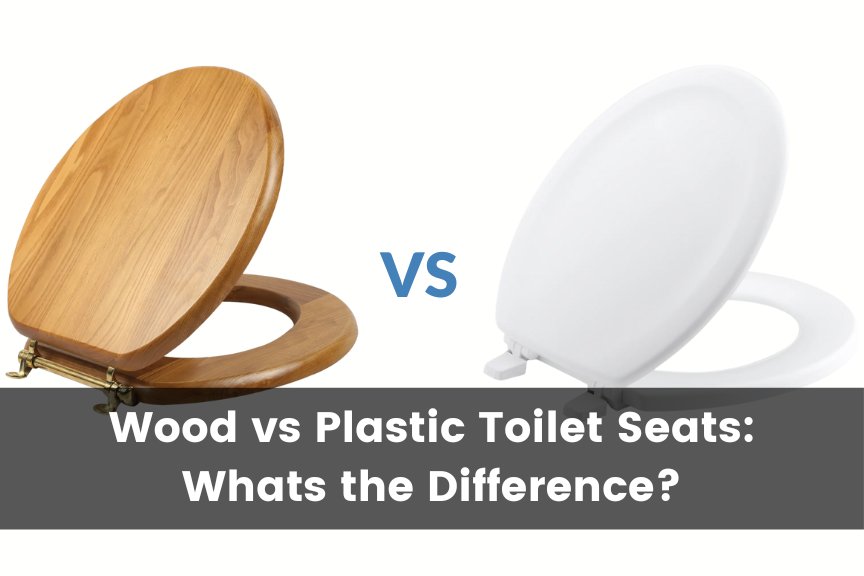Wood vs Plastic Toilet Seat: Which is Better?
Are you looking for a new toilet seat? If so, you probably already know that wood and plastic are the most popular options. Choosing the best option for your home can be challenging if you’re unaware of the advantages and disadvantages of both. So, which is better – wood or plastic?
Wood and plastic toilet seats each have unique benefits and drawbacks. In most cases, plastic is better because it’s more hygienic and longer-lasting than wood. However, a wooden toilet seat adds character and can withstand heavier weight.
This article will explain the differences between plastic and wooden toilet seats. It will also discuss the pros and cons of both so that you can make an informed decision. Let’s dive right in!
Types of Wood Toilet Seats
If a wood toilet seat appeals to you, you’ll need to decide which wood type you prefer. Generally, you have four options:
- Molded wood
- Natural bamboo
- Solid oak
- Oak veneer
Let’s take a deeper look at each of these choices:
- Molded wood. Molded wood is made from a combination of wood flour and resin. The material is extremely dense, making it durable enough to act as a reliable toilet seat, and it’s warm to the touch, which many people find extra comfortable.
- Natural bamboo. Bamboo is an excellent material choice for a toilet seat because it gives the toilet a unique appearance and adds a sense of style to your bathroom decor. Bamboo is also easy to clean, so scrubbing your bathroom won’t be as much of a headache.
- Solid oak. Solid oak is extremely durable and easy to clean, and it also warms to the touch, making it extra comfortable.
- Oak veneer. Oak veneer is easy to clean and sanitize, and the veneer increases the seat’s durability.
Now that you know what wooden toilet seats there are, it’s time to investigate their benefits:
Benefits of Wood Toilet Seats
Wooden toilet seats have a timeless look and appeal, but they’re not as popular as they once were. However, they’re still worth considering because they have a classic style.
Wood toilet seats offer numerous benefits, and here are some features you should consider:
- Wood toilet seats retain body heat. Some people may find this unappealing if someone has used the toilet before them. However, their ability to retain heat can make them more comfortable to use, especially if it’s the first thing on a winter’s morning.
- Wood toilet seats are highly durable. Wood toilet seats can handle more weight than plastic ones, so if you or someone in your household has a heavier body weight, a wood toilet seat is more suitable, durable, and less likely to break than a plastic one.
- Wood seats are more aesthetically pleasing. Your toilet will probably never be the nicest or prettiest thing in your home, but a wood toilet seat makes your porcelain throne appear classier than a plastic seat. Wood may also fit in better with your bathroom’s decor, a huge benefit for interior decorating fans.
Drawbacks of Wood Toilet Seats
Now that you understand the advantages of having a wooden toilet seat, it’s important to learn the disadvantages.
Here are the cons to consider:
- It’s easier to slam a wood toilet seat. One of the main causes of toilet seat damage is slamming the lid down too hard and causing too much pressure, which can eventually lead to breakage. Since they’re heavier than their plastic counterparts, wooden toilet seats can cause more damage. A child’s fingers could get hurt because of a slamming seat.
- Wood is susceptible to infestation. Once the protective coating on the wood wears off, the wood is exposed to the elements and vulnerable to infestation by fungi, bacteria, or other pests such as termites. Typically, you can solve this problem by replacing the toilet seat, which is an annoyance and an inconvenience. However, you can avoid this by ensuring that your toilet seat always has a protective varnish layer.
- Wood isn’t as hygienic as plastic. In the beginning, when the wood toilet seat has many protective layers and enamel, they are extremely hygienic. However, these protective layers begin to flake off over time and leave raw, exposed wood behind. The raw wood, and the closeness of the wood to fecal matter and urine, create a breeding ground for potentially harmful bacteria.
- Wood seats are louder than plastic ones. If you live in a shared space and you have to get up in the middle of the night to use the restroom, the last thing you want is a sudden loud noise to wake up others in the house who are sleeping. Since they are heavier than plastic seats, wooden seats will make a loud noise if you accidentally let them fall too quickly.
- Wood can warp and rot over time. Although wood is durable and long-lasting, you need to treat it properly if you want it to last for several years. Your toilet seat is constantly exposed to sweat, urine, and other bodily fluids, which can cause the material to warp and rot. Wood toilet seats usually don’t last as long as plastic ones.
- You can’t use harsh chemicals on wood toilet seats. Using harsh toilet cleaners can cause your wooden toilet seat’s protective coating to wear off. When cleaning your wooden toilet seat, you must either ensure that the cleaning product doesn’t touch it, or use a more gentle cleaner. This may mean that your wooden toilet seat isn’t as clean as you’d like it.
Benefits of Plastic Toilet Seats
Like wooden toilet seats, plastic seats also have their benefits and drawbacks. Let’s take a look at the benefits first:
- Plastic toilet seats are easy to clean. Plastic is an extremely easy material to keep clean, as all you need to do is wipe away any spillages or imperfections and occasionally apply some cleaner. Unlike wood, there aren’t any grains or cracks where dirt and grime can gather and become breeding grounds for bacteria. This makes them more hygienic.
- Some plastic toilet seats come with a soft-close option. Soft-close toilet seats close more slowly, which leads to less damage to the seat, fewer disturbances because of a sudden loud noise, and fewer fingers getting caught in a slammed seat.
- Plastic is more scratch-resistant than wood. You probably notice scratches all over your home if you have children or pets. Luckily, plastic isn’t that scratchable, so you won’t notice as many annoying scratches on your toilet seat.
- Plastic seats are more affordable than wood ones. If you don’t have a lot of money to spend on a toilet seat, a plastic one would be your best bet. There are many options available, and you can buy a high-quality plastic toilet seat at an affordable price. There are fewer options for cheap wood seats.
Drawbacks of Plastic Toilet Seats
Now that you know all the good things about plastic toilet seats, let’s examine the disadvantages:
- Plastic toilet seats are more prone to stains. Bathrooms are messy places, and unfortunately, your toilet seat is bound to get some urine on it one way or another. Urine is quick to stain plastic, so unless you wipe it off right away, your plastic toilet seat will likely end up with some unsightly stains.
- Plastic can’t handle as much weight. If you have a heavyweight person in the home, plastic probably isn’t the best choice for a toilet seat because it can’t handle as much weight as wood can. Plastic toilet seats can take up to 300 pounds (136 kg), but wood is a safer bet for anyone heavier than that.
- Plastic seats are more uncomfortable. Plastic can get extremely cold, especially in the wintertime. Sitting on a cold toilet seat is an unpleasant experience for many, but it is unavoidable if you have a plastic toilet seat in a cold setting. Furthermore, plastic can feel flimsy and unstable, which isn’t as comfortable as a sturdier seat.
- Plastic isn’t as classy. No one will look down on you if you have a plastic toilet seat; it is the most popular material for toilet seats. However, plastic isn’t necessarily aesthetically appealing and won’t make a stylish statement in your bathroom.
Wood vs. Plastic Toilet Seats: Which Is Better?
Ultimately, the best material for your toilet seat depends on your household, your preferences, and your priorities. Wood can support more weight, is more comfortable, and is more stylish. On the other hand, plastic is more affordable, easier to clean, more hygienic, and quieter.
It’s, therefore, impossible to say if a wood toilet seat is better than a plastic one and vice versa. If you’re still on the fence, the following table outlines some key differences regarding various characteristics to help you with your decision:
| Characteristic | Wood | Plastic | Winner? |
| Strength | Wood is stronger than plastic and can hold up to 400 pounds (181.4 kg) or more of body weight. | Plastic toilet seats usually only hold 300 pounds (136 kg) of weight and tend to break under stress more easily than wood. | Wood |
| Style | Many people prefer the aesthetics of a wood toilet seat over plastic. | Plastic toilet seats aren’t unique and look cheap. However, you can overcome this by buying a high-end model. | Wood |
| Cost | A good quality wooden toilet seat is almost always more expensive than a plastic one. | Plastic toilet seats are generally more affordable than wood. | Plastic |
| Ease of Cleaning | Fecal matter and other grime can easily get stuck in wood grain, making it difficult to reach these places with a cleaning product or tool. | You can easily wipe off any spills or grime on a plastic toilet seat. However, keep in mind that plastic stains easily, especially from urine. | Plastic, but it does stain easily. |
| Hygiene | Wood is less hygienic because once the protective enamel wears off, the raw wood is a breeding ground for harmful bacteria and other pathogens. | Plastic is usually more hygienic than wood because it is easier to clean, and there are fewer places for grime to gather and bacteria to grow. | Plastic |
| Temperature | Wood retains heat better than plastic and doesn’t feel as cold when you sit on it. This makes them more comfortable in winter. | Plastic can be extremely cold and can feel quite cheap and flimsy. | Wood |
| Longevity | Wood rots and warps over time, so it doesn’t last as long as one might hope, especially after the protective enamel wears off. To ensure your wood toilet seat lasts, you’ll need to treat it regularly. | Plastic usually lasts longer than wood because it isn’t as susceptible to pests and bacteria. | Plastic |
| Noise | Wood is heavy, so if you accidentally drop the toilet seat, it will make a loud and disturbing noise. | Plastic toilet seats don’t make as much noise if you accidentally drop them. You can also get soft-close plastic toilet seats. | Plastic |
According to the table above, plastic is the better choice in most categories. However, I recommend getting a wood toilet seat if you have a person who weighs more than 300 pounds (136 kg) regularly using the toilet because plastic won’t be able to bear that weight as effectively as wood can.
If you want your bathroom to have a unique look with some natural elements, wood can enhance its overall appearance. You can get toilet seat covers for your plastic seat if you hate the appearance of the plastic, but these covers don’t look as classy or elegant as real wood.
I recommend getting a plastic toilet seat over a wooden one in almost every other situation. Plastic is usually more affordable, and it is more hygienic, which is important for items that are frequently exposed to potentially harmful waste and bacteria.
The Best Wood Toilet Seats
If you’ve determined that wood is the best choice for you, the next step is finding a high-quality wood seat that fits your bathroom’s design scheme. Below, I’ll recommend some of my favorite wood toilet seat models currently available. All links are to Amazon:
Angol Shiold Store Elongated Toilet Seat
If you have an elongated toilet, I highly recommend this elongated toilet seat from Angol Shiold Store. This seat is compatible with many American toilet brands, including Crane, Eljer, Delta, and Universal Rundle, but only if the toilet has an elongated bowl.
The best part of this toilet seat is its excellent quality. The seat uses artificial planting trees, which maintains the environment, but the wood is as high-quality as you’d need and can support up to 400 pounds (181.4 kg). The seat is also waterproof, moisture-proof, durable, and difficult to break, so it will likely last a long time.
I also appreciate the installation set, which is easy to understand thanks to the clear and precise instructions. Even if you have no plumbing experience, you can assemble this toilet seat in under five minutes.
If for whatever reason, you’re unhappy with the seat, Angol Shiold will replace the seat free of charge within one year.
SUFISEAT Wood Toilet Seat
If you have a regular round toilet seat, not an elongated one, this seat from SUFISEAT is my recommendation. You can choose between dark brown and light wood for the color, so you can buy the option that best suits your bathroom decor. I also like that the seat fits most American round toilet seats, so you won’t have to deal with a misfit in most cases.
The seat has built-in curves that fit the human body’s natural curves, so you can sit on the seat for an extended period without getting uncomfortable. The thick solid wood and the metal hinges can withstand 400 pounds (181.4 kg).
One of the main drawbacks of wood toilet seats is how loud they are if they slam shut, but you don’t need to worry about that issue with this seat. The seat has shock-absorbing pads that remove the loud slamming noise if you accidentally drop the lid.
The Best Plastic Toilet Seats
If you’ve decided that plastic is the best option for you, you have plenty of options for great seats! Here are a couple of my suggestions from Amazon:
BEMIS Toilet Seat
This affordable toilet seat is a popular choice for a plastic seat. It’s extremely easy to install, and the seat fastening system installs from the top, eliminating the need for anyone to get down on their hands and knees during the installation process.
The plastic is resilient and comes with a molded-in color resistant to all scratches, chips, wear, and stains. As a result, this toilet seat looks as good as new for longer.
Mayfair Caswell Toilet Seat
My favorite part of this seat is its no-slamming feature, which always closes slowly. This eliminates disturbing noises and a child’s chances of hurting their fingers because of a slammed lid. The seat also comes with a fastening system that keeps the lid tight, so you don’t have to deal with it wiggling around as you’re using it.
The seat is made with resilient plastic resistant to chips, stains, and breakage. It fits all American standard round toilets.
Conclusion
The best toilet seat for you depends on your household and the people regularly using the toilet. In most cases, plastic is better than wood because it is more affordable and hygienic and lasts longer than wood. However, wood is the best option for people who want a classy bathroom and those who weigh more than 300 pounds (136 kg).







